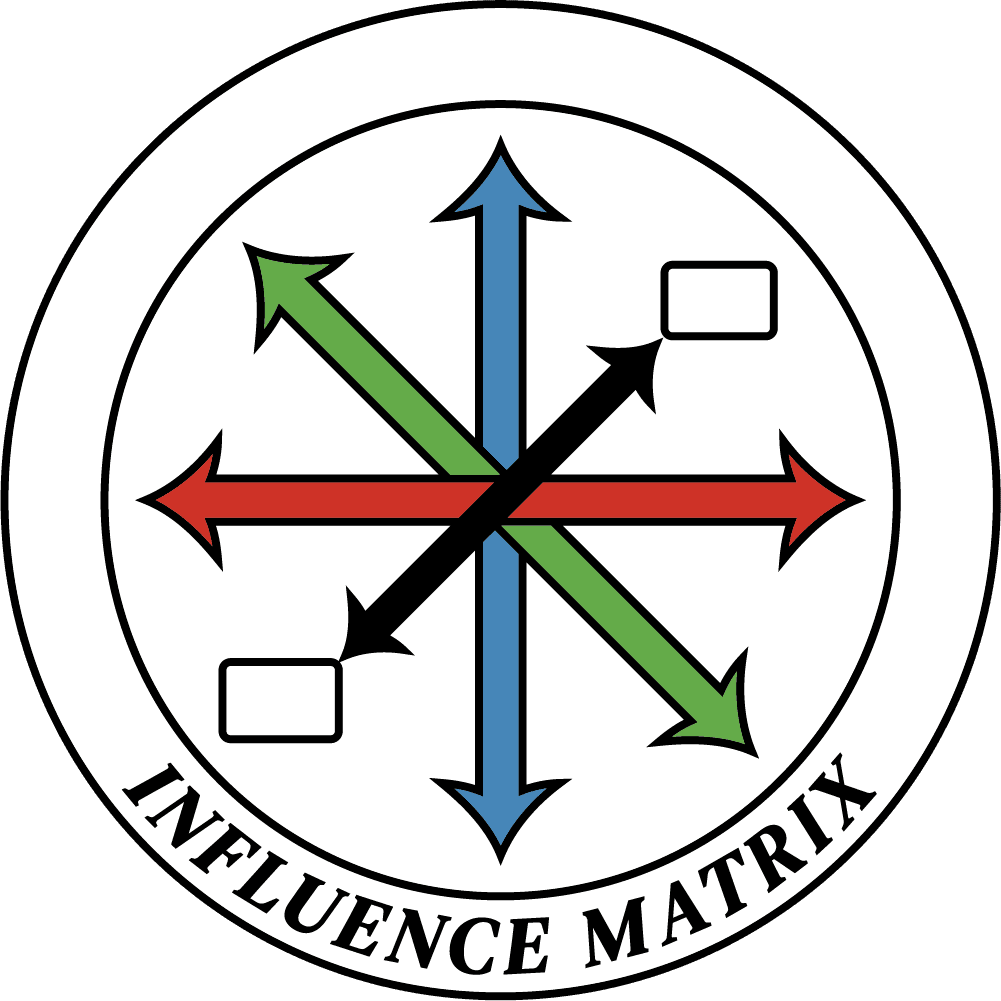The Influence Matrix is a central element of UTOK, providing a comprehensive map of human relationship systems. It integrates insights from attachment theory and interpersonal dynamics to explain how socio-motivational processes shape self-other relationships and influence human behavior within UTOK’s framework.
Core Components of the Influence Matrix
The Influence Matrix identifies two fundamental socio-motivational processes: relational value and social influence. These processes are collectively represented as the RVSI (Relational Value and Social Influence) line in the matrix.
Relational Value
Relational value refers to the fundamental human need to be seen, known, and valued by others. This concept is deeply rooted in human evolutionary history, where social bonds and group cohesion were crucial for survival and reproduction. The need for relational value drives behaviors aimed at gaining acceptance, affection, and affirmation from significant others.
Social Influence
Social influence is the capacity to affect others in accordance with one's interests and goals. It encompasses various forms of power dynamics, including persuasion, authority, and coercion. Social influence is essential for navigating social hierarchies and achieving personal and collective objectives.
Dimensions of Self-Other Processes
The Influence Matrix maps three critical dimensions of self-other processes: Power, Love, and Freedom.
Power
The Power dimension reflects hierarchical dynamics in human relationships, ranging from dominance to submission. It is depicted as the blue line in the matrix. This dimension highlights how individuals navigate authority, control, and social status within their interactions.
Love
The Love dimension represents the spectrum of affiliation and prosociality, ranging from hostility to affiliation. It is depicted as the red line in the matrix. This dimension underscores the importance of empathy, compassion, and cooperative behaviors in fostering strong social bonds.
Freedom
The Freedom dimension captures the dynamics of self-other involvement on a continuum between dependency and autonomy. It is depicted as the green line in the matrix. This dimension addresses the balance between interdependence and individual autonomy, emphasizing the need for both connectedness and personal freedom in healthy relationships.
Integrative Framework
The Influence Matrix integrates the above components into a coherent framework that can be visualized through its diagrammatic representation. This integrative approach allows for a comprehensive understanding of human relational dynamics, offering valuable insights for psychology, psychotherapy, and interpersonal development.
Theoretical Foundations
The theoretical foundations of the Influence Matrix are built upon the synthesis of Attachment Theory and the Interpersonal Circumplex.
Attachment Theory: Developed by John Bowlby, this theory emphasizes the importance of early relationships in shaping an individual's emotional and social development. The Influence Matrix incorporates the core principles of attachment, such as the need for security, proximity, and responsive caregiving.
Interpersonal Circumplex: Proposed by Timothy Leary, this model maps interpersonal behaviors along dimensions of dominance-submission and warmth-hostility. The Influence Matrix extends this model by integrating the additional dimension of freedom, offering a more nuanced understanding of relational dynamics.
Applications and Implications
The Influence Matrix has wide-ranging applications in various fields, including psychology, psychotherapy, and organizational behavior.
Psychology and Psychotherapy
In psychology and psychotherapy, the Influence Matrix provides a robust framework for understanding and addressing relational dynamics and socio-motivational processes. It aids in diagnosing and treating relational disorders, enhancing therapeutic interventions, and promoting psychological well-being.
Relational Disorders: The Influence Matrix helps identify patterns of relational dysfunction, such as attachment disorders, dependency issues, and power imbalances. By mapping these patterns, therapists can develop targeted interventions to address specific relational challenges.
Therapeutic Interventions: The Influence Matrix guides the development of therapeutic interventions aimed at enhancing relational value, balancing social influence, and fostering healthy self-other dynamics. Techniques such as attachment-based therapy, cognitive-behavioral approaches, and relational psychotherapy can be informed by the matrix.
Psychological Well-being: Understanding and optimizing relational dynamics through the Influence Matrix contributes to overall psychological well-being. By fostering secure attachments, healthy power dynamics, and balanced autonomy, individuals can achieve greater emotional and social fulfillment.
Organizational Behavior
In organizational behavior, the Influence Matrix offers valuable insights into leadership, team dynamics, and organizational culture.
Leadership: The matrix provides a framework for understanding different leadership styles and their impact on relational value and social influence. Effective leaders can use this understanding to foster positive relationships, motivate team members, and navigate power dynamics.
Team Dynamics: The Influence Matrix helps identify and address issues related to team cohesion, conflict resolution, and collaborative behaviors. By mapping the relational dynamics within a team, organizations can implement strategies to enhance communication, trust, and collaboration.
Organizational Culture: The matrix informs the development of organizational culture by highlighting the importance of relational value, social influence, and balanced self-other dynamics. Organizations can use this framework to create a culture that promotes inclusivity, respect, and mutual support.
Empirical Support and Future Directions
The Influence Matrix is supported by empirical research and continues to evolve through ongoing studies and applications. Future research directions include:
Empirical Validation: Conducting empirical studies to validate and refine the theoretical constructs of the Influence Matrix. This includes examining the relationships between relational value, social influence, and self-other dimensions across diverse populations and contexts.
Cross-cultural Applications: Exploring the cross-cultural applicability of the Influence Matrix. Understanding how cultural variations impact relational dynamics and socio-motivational processes can enhance the matrix's global relevance.
Technological Integration: Leveraging technology to develop tools and applications based on the Influence Matrix. This includes creating digital platforms for assessing relational dynamics, providing personalized feedback, and offering virtual interventions.
Conclusion
The Influence Matrix is a powerful tool for understanding and enhancing human relationships within the framework of UTOK. By integrating insights from Attachment Theory and the Interpersonal Circumplex, the matrix provides a comprehensive map of socio-motivational processes and self-other dimensions. Its applications in psychology, psychotherapy, and organizational behavior offer valuable insights for promoting relational value, optimizing social influence, and balancing autonomy and interdependence. As empirical research continues to validate and expand the Influence Matrix, its potential for fostering healthier, more fulfilling relationships remains profound.
By understanding and applying the principles of the Influence Matrix, we can navigate the complexities of human relationships with greater clarity and effectiveness. Whether in personal interactions, therapeutic settings, or organizational contexts, the matrix offers a robust framework for fostering positive relational dynamics and achieving holistic well-being.
For further exploration, consider delving into the foundational works that inform the Influence Matrix, including Bowlby's Attachment Theory and Leary's Interpersonal Circumplex, as well as the broader UTOK framework that situates the matrix within a comprehensive system of knowledge.
Links & Resources
Influence Matrix Introduction Video
A short video introduction to the Influence Matrix concept by Gregg Henriques.
Essays on the Influence Matrix
A collection of essays exploring the Influence Matrix and its implications for understanding human relationships.Chapter on the Influence Matrix
A detailed chapter from UTOK's published literature discussing the Influence Matrix in depth.TOK Thrive Community Meeting Discussion
Watch a recorded discussion from a UTOK Thrive Community Meeting that covers the Influence Matrix in practice.Article: Relational Value and Social Influence
A blog post diving deeper into the core social motives outlined in the Influence Matrix.





